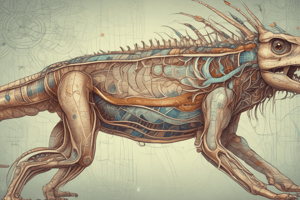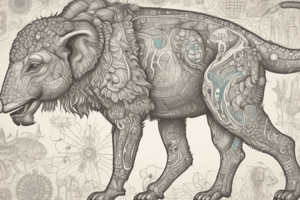Podcast
Questions and Answers
Which physiological system is responsible for breaking down food into nutrients?
Which physiological system is responsible for breaking down food into nutrients?
What does homeostasis refer to in the context of physiological systems?
What does homeostasis refer to in the context of physiological systems?
Which system is responsible for transporting nutrients, oxygen, and hormones throughout the body?
Which system is responsible for transporting nutrients, oxygen, and hormones throughout the body?
What is the main function of the excretory system?
What is the main function of the excretory system?
Signup and view all the answers
How does the respiratory system contribute to homeostasis?
How does the respiratory system contribute to homeostasis?
Signup and view all the answers
What is the primary difference between ectothermic and endothermic animals?
What is the primary difference between ectothermic and endothermic animals?
Signup and view all the answers
How do marine algae called zooxanthellae contribute to corals?
How do marine algae called zooxanthellae contribute to corals?
Signup and view all the answers
Which innovative approach in animal physiology research involves predicting changes in physiological processes through simulations?
Which innovative approach in animal physiology research involves predicting changes in physiological processes through simulations?
Signup and view all the answers
What physiological process occurs when gas inhaled by the lungs enters blood vessels?
What physiological process occurs when gas inhaled by the lungs enters blood vessels?
Signup and view all the answers
How do birds navigate during migration based on the text?
How do birds navigate during migration based on the text?
Signup and view all the answers
Study Notes
Zoology: A Comprehensive Overview of Animal Physiology
Animal physiology is the branch of zoology concerned with the study of the functions, processes, and responses of animals' organ systems and their interactions within living organisms. This interdisciplinary field encompasses various aspects of biology, including molecular mechanisms, cellular function, physiological adaptation, and the internal and external factors that influence these processes. In this article, we will delve into the fascinating world of animal physiology, exploring its key components and the importance of understanding it within the broader context of zoology.
Structure of Physiological Systems
Physiological systems can be broadly categorized into four main sections: respiratory, digestive, excretory, and circulatory systems. These systems work together to maintain homeostasis, which refers to the balance of bodily functions necessary for survival:
- Respiratory System: Ensures gas exchange between the body and its environment through breathing.
- Digestive System: Breaks down food into nutrients, providing energy and materials essential for growth and maintenance.
- Excretory System: Removes waste products from the body via kidneys and other organs.
- Circulatory System: Transports nutrients, oxygen, and hormones throughout the body and eliminates waste products.
These systems interact with one another in complex ways, illustrating the intricate harmony of life at various levels of organization. For instance, gas inhaled by our lungs enters blood vessels, where hemoglobin molecules bind oxygen, forming oxyhemoglobin. Blood carries oxyhemoglobin to tissues such as muscle tissue, where oxygen dissociates and diffuses into cells, delivering energy required for muscular contractions.
Adaptation and Evolutionary Perspectives
The study of animal physiology provides valuable insights into how species have adapted to diverse environments over time. Understanding these adaptations contributes to our knowledge of evolutionary processes, allowing us to trace the developmental history of species. Some examples of notable physiological adaptations among different groups of animals include:
- Camouflage: Many insects and arthropods possess specialized pigmentation patterns or structural colors that enable them to blend seamlessly with their surroundings.
- Bird Migration: Birds exhibit remarkable navigation abilities during migration, using sun compass orientation cues and Earth's magnetic fields.
- Ectothermy vs Endothermy: Ectothermic animals, like reptiles and amphibians, rely primarily on environmental conditions for temperature regulation, while endothermic animals, such as mammals and birds, generate heat internally.
- Photosynthesis in Animals: Certain marine algae called zooxanthellae live symbiotically inside the bodies of some corals, releasing glucose into the host, effectively performing photosynthesis within the animal itself.
Emerging Trends in Zoology Research
As technology advances, researchers are increasingly leveraging cutting-edge techniques to explore animal physiology in unprecedented detail. Some innovative approaches currently gaining traction include:
- Computational Modeling: Mathematically modeling biological systems allows scientists to simulate and analyze complex phenomena, predicting how changes might affect physiological processes.
- Microbiome Studies: Investigating the communities of microorganisms present in animals' habitats and bodies reveals their roles in health, disease, and behavior.
- Non-Invasive Monitoring Techniques: Advances in imaging technologies, such as magnetic resonance imaging (MRI) and positron emission tomography (PET), allow researchers to visualize and measure physiological functions without directly intervening in the animal's body.
Conclusion
In conclusion, the field of animal physiology represents a critical junction where many branches of biology converge, shedding light on the inner workings of life as well as its evolutionary trajectory. By studying these processes in a variety of animals, researchers can draw parallels and contrasts, ultimately leading to a more comprehensive understanding of life's complexity. As scientific progress continues apace, the future holds exciting possibilities for the exploration of zoology and its subdisciplines, including animal physiology.
Studying That Suits You
Use AI to generate personalized quizzes and flashcards to suit your learning preferences.
Description
Test your knowledge of animal physiology with this quiz covering the physiological systems, adaptation, evolutionary perspectives, and emerging trends in zoology research. Explore the intricate interactions of respiratory, digestive, excretory, and circulatory systems, and delve into how animals have evolved and adapted to diverse environments over time.




